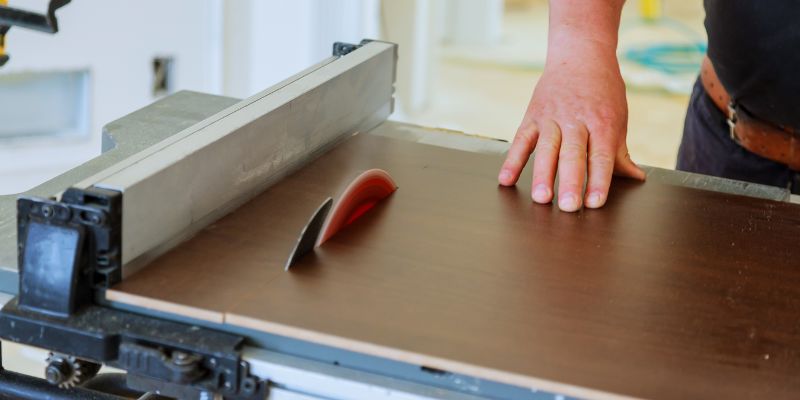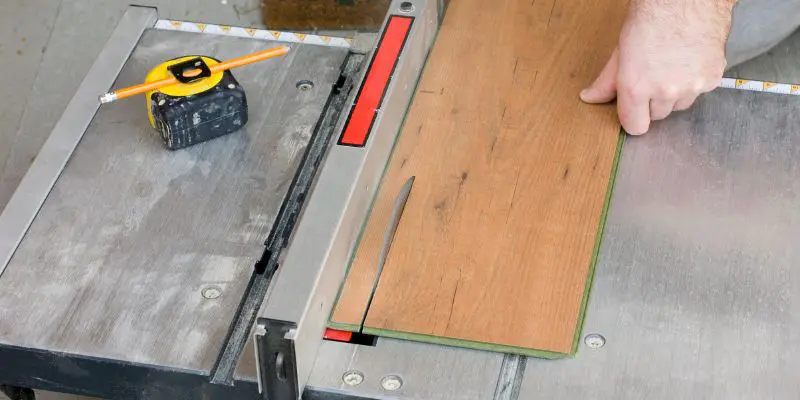Looking to create a DIY table saw? Here’s a quick and accurate guide for you.
Table saws are versatile and essential tools for woodworking projects. Whether you’re a novice or experienced DIY enthusiast, building your table saw can save money and customize it to fit your specific needs. This introduction will provide a comprehensive overview of the steps and materials required to complete your DIY table saw.
From safety precautions to the selection of the right materials and the assembly process, this guide aims to equip you with the knowledge and confidence to embark on this rewarding DIY project. Follow along as we delve into the details of creating your very own table saw from scratch.
Table Saw Diy Essentials
When it comes to DIY woodworking projects, a table saw is an essential tool for making precise and accurate cuts. However, before diving into your next project, it’s crucial to understand the table saw DIY essentials. From knowing your table saw’s capabilities to ensuring proper maintenance checks and having the essential safety gear, these are the foundational aspects to keep in mind for a successful and safe woodworking experience.
Understanding Your Table Saw’s Capabilities
Before you start any woodworking project with a table saw, it’s important to understand its capabilities. Different types of table saws have varying features and functions, such as rip capacity, bevel angles, and cutting depth. Take the time to familiarize yourself with your specific table saw’s abilities to ensure you can leverage its full potential for your DIY projects.
Maintenance Checks Before Starting
Prior to engaging in any woodworking task, it’s essential to conduct thorough maintenance checks on your table saw. This includes inspecting the blade for any damages or dullness, ensuring the fence and miter gauge are properly aligned, and verifying that all safety features are operational. By performing these maintenance checks, you can mitigate the risk of accidents and maintain the efficiency of your table saw.
Essential Safety Gear For Table Saw Use
Safety is paramount when operating a table saw. An indispensable part of your DIY essentials is having the necessary safety gear. This includes safety goggles to protect your eyes from wood particles, hearing protection to reduce the noise level, and a push stick to keep your hands at a safe distance from the blade. Additionally, having a sturdy pair of gloves can add another layer of protection during handling and adjustments. Prioritizing safety gear minimizes the potential for accidents and contributes to a secure woodworking environment.

Choose The Right Blade
When it comes to using a table saw for DIY projects, choosing the right blade is crucial for achieving accurate and clean cuts. Whether you are cutting wood, metal, plastic, or other materials, selecting the appropriate blade will significantly impact the quality of your work. Understanding your project requirements, the types of table saw blades available, and proper blade installation and alignment are essential elements in ensuring the success of your cutting tasks.
Assessing Project Requirements
Before selecting a table saw blade, it’s important to assess the specific requirements of your project. Consider the type of material you will be cutting, the thickness, and the desired finish. For instance, if you are working with hardwood, a blade with more teeth and a higher tooth count may be necessary to achieve a smoother finish, while for rough cuts in construction lumber, a blade with fewer teeth might be more suitable.
Types Of Table Saw Blades
There are various types of table saw blades available, each designed for specific cutting tasks. Understanding the differences between them is critical in choosing the right blade for your project. Blades can vary based on their tooth count, tooth design, material they are designed to cut, and their overall purpose. Some common types include rip blades, crosscut blades, combination blades, and specialty blades for specific materials such as plywood or metal.
Blade Installation And Alignment
Once you have chosen the appropriate blade for your project, ensuring correct installation and alignment is essential for achieving precise cuts. Proper blade installation involves securing the blade onto the arbor, adjusting the blade to the correct height, and aligning it parallel to the miter slot or rip fence. Any misalignment can lead to inaccurate cuts and compromise the safety of the operation.
By understanding your project requirements, familiarizing yourself with the types of table saw blades available, and ensuring the proper installation and alignment of the chosen blade, you can maximize the performance of your table saw and achieve professional results in your DIY endeavors.
Master Your Craft With Tips
Mastering the art of using a table saw can take your woodworking projects to the next level. With the right techniques and precision, you can achieve professional-quality cuts that elevate the overall finish and detail of your creations. Whether you’re a seasoned woodworker or just starting out, these tips will help you hone your skills and elevate your craftsmanship.
Making Precise Cuts
When it comes to woodworking, precision is paramount. To ensure precise cuts with your table saw, it’s essential to begin with accurate measurements and alignments. Calibrating your table saw regularly and using high-quality blades can make a significant difference in the accuracy of your cuts. Additionally, incorporating a zero-clearance insert and installing a reliable fence system can help minimize error and ensure precise cuts every time.
Techniques For Common Cuts
Knowing the right techniques for common cuts can greatly enhance your woodworking projects. Whether it’s a crosscut, rip cut, or bevel cut, having a firm grasp of proper techniques can make a world of difference in the quality of your work. Utilizing push sticks, featherboards, and miter gauges can improve safety and control when executing these cuts. Understanding the nuances of each cut and employing the appropriate techniques can elevate the accuracy and efficiency of your work.
Jigs And Fixtures For Enhanced Precision
Incorporating jigs and fixtures into your workflow can take your precision to the next level. Custom-built sleds, taper jigs, and box joint fixtures can expand the capabilities of your table saw and enhance the precision of your cuts. These fixtures not only improve accuracy but also provide consistency across multiple pieces, ensuring a professional finish. By investing time in creating or utilizing these jigs and fixtures, you can elevate the quality of your woodworking projects and master the craft of using a table saw.
Craftsmanship Enhancements
When it comes to woodworking, the finesse of your craftsmanship can make a significant impact on the quality of your finished product. With the right table saw DIY enhancements, you can take your woodworking skills to the next level. Let’s delve into some craftsmanship enhancements that can transform the way you work with your table saw.
Fine-tuning Table Saw Settings
One of the key aspects of improving your craftsmanship with a table saw is fine-tuning the settings for precision cutting. Make sure to adjust the blade angle, fence alignment, and blade height to ensure accurate cuts and reduce wastage of materials. By paying attention to these details, you can elevate the quality of your woodworking projects.
Advanced Cutting Techniques
Mastering advanced cutting techniques can set your woodworking apart. Experiment with dado cuts, rabbets, and bevels to expand your repertoire and create intricate designs. Understanding the right use of different blades and mastering the art of intricate cuts can take your craftsmanship to new heights.
Utilizing Table Saw Extensions
Incorporating table saw extensions can greatly enhance your workspace, allowing you to handle larger materials with ease. This addition can also improve the accuracy of your cuts, leading to a finer end result. Whether it’s a router table extension, outfeed extension, or table widening attachment, these extensions can vastly expand the capabilities of your table saw.

Seamless Workflow Optimization
When working with a table saw, achieving a seamless workflow is essential for maximizing efficiency and safety. By optimizing your workspace, implementing efficient cutting sequences, and maintaining your table saw properly, you can enhance your woodworking experience and ensure precise results.
Organizing Your Workspace
Creating a well-organized workspace is the foundation for a seamless workflow. Consider implementing the following strategies to keep your workspace clean and efficient:
- Clear the clutter: Remove any unnecessary items from your work area to reduce distractions and ensure easy access to your tools and materials.
- Utilize storage solutions: Invest in storage bins, shelves, and tool organizers to keep your workspace tidy and organized, enabling quick access to essential items.
- Optimize layout: Arrange your tools and work surfaces in a logical manner to minimize movement and maximize productivity while using the table saw.
Implementing Efficient Cutting Sequences
To streamline the cutting process and optimize efficiency when using a table saw, consider the following tips for implementing efficient cutting sequences:
- Batch cutting: Plan your cuts to minimize blade adjustments and optimize material usage, especially when working on multiple pieces with similar dimensions.
- Use jigs and fixtures: Employ specialized jigs and fixtures to facilitate accurate and repeatable cuts, reducing the need for manual adjustments and improving consistency.
- Pre-cut material preparation: Prepare your materials in advance, ensuring they are properly sized and oriented for efficient feeding into the table saw, thereby reducing setup time and minimizing waste.
Table Saw Cleaning And Maintenance Post-use
Maintaining a clean and well-maintained table saw is crucial for its optimal performance and longevity. After each use, follow these steps to ensure proper cleaning and maintenance:
- Remove debris: Thoroughly clean the table saw surface, blade, and surrounding area to eliminate sawdust, wood chips, and other debris that can affect cutting accuracy and pose safety hazards.
- Inspect moving parts: Check the blade, arbor, and other moving components for any signs of wear or damage, and lubricate as necessary to maintain smooth operation.
- Review alignment and calibration: Periodically check and recalibrate the blade alignment, fence, and miter gauge to ensure precise and accurate cuts, making any necessary adjustments as needed.
Diy Projects Inspiration
DIY projects can be an incredibly satisfying way to put your woodworking skills to the test and create functional, beautiful pieces for your home or workspace. Whether you’re a complete beginner or a seasoned pro, there’s always something new to learn and create. If you’re looking for inspiration for your next table saw DIY project, you’ve come to the right place!
Beginner-friendly Project Ideas
If you’re new to woodworking or just starting out with your table saw, there are plenty of simple and exciting projects to get you started. Building a basic bookshelf, constructing a simple coffee table, or creating custom picture frames are all excellent projects for beginners. Start with straightforward designs and gradually challenge yourself with more intricate and detailed pieces as your skills improve.
Resources For Further Learning And Community Engagement
As with any DIY project, it’s essential to have access to valuable resources and a supportive community. Online woodworking forums and social media groups can provide a wealth of information, tips, and advice from experienced woodworkers. Woodworking websites and YouTube tutorials are also excellent resources for learning new techniques and gaining inspiration for your next project. Connecting with like-minded individuals who share your passion for woodworking can greatly enhance your DIY experience.
Expanding Beyond The Basics With Creative Projects
Once you’ve mastered the fundamentals of using a table saw, it’s time to push the boundaries and explore more creative and challenging projects. Consider designing and building a unique dining table, crafting a customized storage solution, or creating intricate wooden decorations for your home. Experimenting with unconventional materials and blending different woodworking styles can lead to truly innovative and striking pieces that showcase your skills and imagination.
Frequently Asked Questions On Table Saw Diy
What Safety Measures Should I Take When Using A Diy Table Saw?
When using a DIY table saw, always wear protective gear, such as goggles and gloves. Ensure the blade guard is in place and the work area is clear of clutter. Follow proper techniques and never leave the saw unattended while it’s running.
How Can I Maintain My Table Saw For Optimal Performance?
Regularly clean the saw and lubricate moving parts. Check the blade alignment and tension, and replace it when dull. Keep the tabletop clean and rust-free. Periodically inspect the electrical components for any signs of wear or damage.
What Are The Essential Accessories For A Diy Table Saw?
Essential accessories for a DIY table saw include a push stick for safety, a miter gauge for precise angle cuts, a featherboard for added stability, and a quality rip fence for accurate and consistent cuts. Invest in a sturdy stand or mobile base for portability.
Conclusion
Incorporating a table saw DIY project into your woodworking endeavors can elevate your skills while saving costs. By following safety measures and precise techniques, you can amplify your craftsmanship with every cut. Enjoy the satisfaction of crafting personalized pieces and honing your skills with a self-made table saw.
Embark on your DIY journey today!


